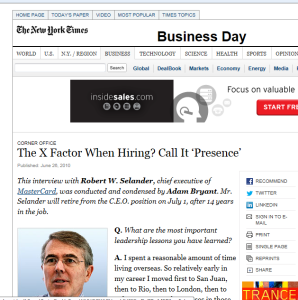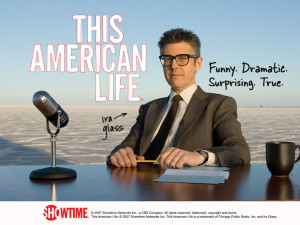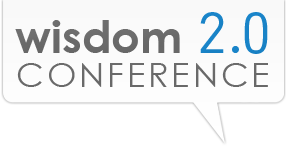 Thanks to Mike Linardi’s ezine, I discovered the Corner Office column in the NY Times, where Adam Bryant reports on conversations he’s had with CEOs about key issues. One that caught my attention was an interview with Robert W. Selander, the CEO of Mastercard on the importance of presence.
Thanks to Mike Linardi’s ezine, I discovered the Corner Office column in the NY Times, where Adam Bryant reports on conversations he’s had with CEOs about key issues. One that caught my attention was an interview with Robert W. Selander, the CEO of Mastercard on the importance of presence.
Presence is such a key factor in our ability to communicate, because it profoundly affects whether we are our message or whether who we are conflicts with what we say.
Because of this, I was excited to read what Robert W. Selander had to say about this important quality.
However, as I read what he said about presence, I found myself at first confused and then with a useful “Ah hah!”.
Here’s what he said about presence:
Can you elaborate more on what you mean by presence?
A. At varying levels in the company, you interact with different stakeholders. Having somebody spend time with a member of Congress is very different than having somebody go downstairs and see that they were appropriately replacing a torn carpet. You need a different capability to deal with those circumstances, not only from a knowledge standpoint but from a presence standpoint.
As I’ve gone through my career, I’ve been challenged to deal with different stakeholders. Internally, when I was younger and more junior, I probably did pretty well with peers. But then how do you credibly communicate with more senior people, who are not as concerned about some things perhaps in the details, but they want a bigger picture?
So it’s a combination of not only how you convey things, but what you convey to these various stakeholders. Presence is learning to deal with different audiences in a way that allows them to get what they need out of this interaction and ensures that the well-being of the company is looked after.
Q.Isn’t that what some people describe as just good communication skills?
A. I think you can be a good communicator and you still may not have presence. There may be someone who is very articulate on a subject and they know levels of detail. When you get with a particular audience, it may not be appropriate to go into those levels of detail, or you may create doubt by even going into the subject matter. There’s inside information in a company, for example. You never cross that bright line, but you can get varying degrees of proximity to that line, depending on your audience.
Some people are not very good communicators, but boy, when you get them into their subject matter they know exactly where to go and how far to go. Others are brilliant communicators, but because of the connection between their thoughts and the synapses firing and the words coming out, there isn’t enough time and introspection. Therefore they will brilliantly communicate something that they shouldn’t be talking about. Presence is knowing what to communicate, and how.
Now, when you read what he describes as “presence”, did that match your definition of presence?
It sure didn’t match mine.
I found myself thinking “the interviewer is right…what he’s talking about is communication skills…about being adaptable and speaking in ways that work with your audience”.
What he described as “presence” is very different from what I think of when I think of presence.
Why should you care about this?
Understanding what other people’s Complex Equivalents for abstract terms like “presence”, “leadership” or “authenticity” or “great customer service” is important if you want to truly understand what they’re saying.
Explaining your Complex Equivalents by illustrating examples is important if you want your audience to truly understand what you are saying.
What’s a Complex Equivalent?
What’s a Complex Equivalent you ask?
Here’s a definition of Complex Equivalent from NLP Akadamesi.com
“The individual’s cognitive map or sensory representation of a particular word, label or expression; the meaning they assign to an abstract form of words. A different experience or action that has the same meaning for an individual as the experience they are considering. Misunderstanding occurs when two individuals each assign meaning to an abstract word or phrase and then act as if they were using a shared, defined meaning.”
So, while two people might use the term “respect” and say they show people respect, their Complex Equivalents could be very different.
So for instance, one person could challenge people aggressively, point out people’s flaws in front of others, and shoot down ideas using harsh judgments, all the time seeing themselves as respectful. For another, “respect” might equal not disagreeing with people in public, not pointing out people’s mistakes or shortcomings, etc.
So what?
1. We must never assume we know what someone means, just because they use the same term as we do. When coaching and consulting, you want to explore what people mean when they use important terms. Ask them for examples.
2. We need to explain our Complex Equivalents if we want people to understand what we’re saying at a concrete, visceral level.
So how can you use this knowledge?
1. For important terms you often use in your presentations or coaching, come up with specific examples that illustrate and explain those terms.
2. When using abstract terms, follow up with “So for instance…” and “What I mean by that is….” or “An example of that would be…” – This makes it MUCH easier for the human brain to comprehend and make neural connections. Remember, the more abstract a concept, the farther it is from reality, and therefore the harder it is for the brain to process (and therefore the more quickly someone will give up trying to understand).
Conversely, the more concrete and sensory rich communication is, the more it impacts at an emotional, visceral level, and the more easily understood it is. Also the more abstract a term is, the more likely someone will fill in the blanks with their own Complex Equivalents. This can often result in them completely missing your point, while thinking they get it.
By the way, here’s an example of “for instance…”
Remember what you read a moment ago:
Remember, the more abstract a concept, the farther it is from reality, and therefore the harder it is for the brain to process (and therefore the more quickly someone will give up trying to understand). Conversely, the more concrete and sensory rich communication is, the more it impacts at an emotional, visceral level, and the more easily understood it is.
Well that’s pretty darn abstract, is it not?
Well, let’s make it more concrete and therefore more understandable…
“So for instance, think of the difference between having someone hug you and having someone include in their email ‘Bug Hug.” One is more concrete and sensory rich than the other, and has a much bigger impact. Compare the level of abstractness between the smiley face emoticon 🙂 , reading “She laughed uproariously”, hearing an audio recording of someone laughing, or actually being in the presence of someone laughing. Notice how as you slide along the continuum of abstract to concrete and sensory rich, the experience and impact increases.
This is one of the reasons why stories shine as communication devices. They make ideas come alive because they turn ideas into experiences, because they are sensory rich and visceral.
So…remember to ask about other people’s Complex Equivalents and give examples of yours.








